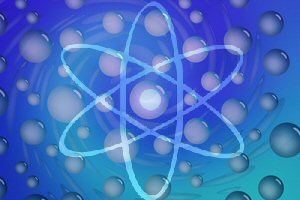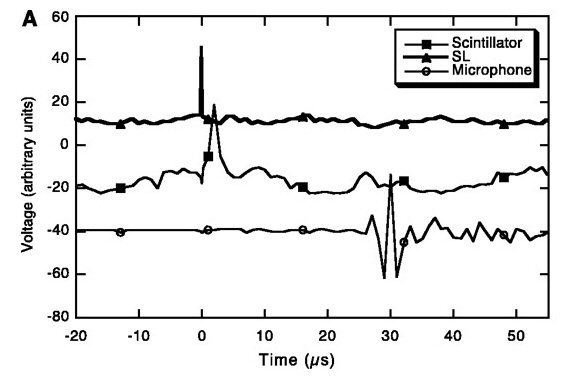
Oak Ridge Nuclear Cavitation Confirmation
July 24, 2013 – By Steven B. Krivit –
This is Part 7 of “2001 Oak Ridge Nuclear Cavitation Confirmation Uncovered.”
This is a New Energy Times Special Report. The first part of this series published on July 18, 2013.
Taleyarkhan Group Responds to Shapira and Saltmarsh (March 2, 2002)
The Taleyarkhan group’s rebuttal to Shapira and Saltmarsh, “Comments on the Shapira and Saltmarsh Report,” dated March 2, 2002, and listed as reference #32 in the Science paper, revealed problems with the way Shapira and Saltmarsh analyzed the neutron singles emissions as well as the neutron/SL flash coincidence data. The Taleyarkhan group calculated that the neutron data from the Shapira and Saltmarsh (PD) detector revealed statistically significant neutron emissions, more than 10 standard deviations.
“Contrary to [Shapira and Saltmarsh’s] conclusions, a statistically significant increase of nuclear emissions was actually detected by them during cavitation experiments with chilled deuterated acetone,” the Taleyarkhan group wrote.
The group explained how Shapira and Saltmarsh grossly over-estimated the efficiency of their detector.
“Unfortunately, the significantly larger size of the PD detector made this system much more prone to background radiation and electronic-saturation-related problems,” the Taleyarkhan group wrote. “Indeed, the recommended size detector for 2.5 MeV neutrons is ~100cc (which is the size of the Elscint (ET) detector used by us in our experiments). … This implies that only 10 out of every 10^6 2.5 MeV neutrons would be detected by the PD detector, as a consequence of its location and threshold level.”
Bigger is not always better, the Taleyarkhan group made clear in explaining why the Shapira and Saltmarsh neutron detector was not optimal for this experiment.
“Due to the large size of the PD detector,” the Taleyarkhan group wrote, “it could not be positioned within the experimental enclosure. … Significantly, the PD detector was [effectively] shielded from the experimental chamber by a ~6-mm-thick plastic wall covered with 1.5- to ~2-inch-thick refrigeration pack materials for enclosure cooling.”
The Taleyarkhan group also wrote about the apparent lack of calibration of the PD detector by Shapira and Saltmarsh. Shapira and Saltmarsh’s Feb. 20, 2002, draft says that they used, in addition to a Pu-Be source, a cobalt-60 source before the experiment for calibration. However, their first written analysis on July 31, 2001, did not mention such calibration.
The Taleyarkhan group wrote that Shapira and Saltmarsh wrote in another document that Shapira and Saltmarsh used cesium-137 to calibrate, instead. But no Cs-137 or Co-60 sources existed in the Taleyarkhan group’s laboratory at the time of the PD experiments. After a detailed analysis of the inefficiency of the PD detector, the Taleyarkhan group calculated that “only 10 out of every 10^6 2.5 MeV neutrons would be detected by the PD detector as a consequence of its location and threshold level.”
“Neither Shapira nor Saltmarsh calibrated their detector for 2.45 MeV neutrons with Co and Cs sources,” Taleyarkhan wrote. “This I am sure of. We did not have the clearance at that time to possess these. As a consequence, they had set their LLD almost at the 2.45 MeV edge since they were more fascinated with capturing the 14 MeV neutrons emitted from the PNG rather than the 2.45 emitted from the cell and had a huge gamma background to contend with as a consequence of the x30 larger detector and the intervening ice packs.”
Unprofessional Behavior (March 2, 2002)
After its technical conclusion, the Taleyarkhan group had a few words to say about Shapira and Saltmarsh’s premature distribution of the draft document.
“The resultant (Feb. 20) internal ORNL report, which was never subjected to peer review, was unfortunately widely disseminated, and this has led to a lot of controversy concerning our experimental findings,” the Taleyarkhan group wrote. “Indeed, some people may have reached conclusions concerning the validity of our findings prior to the publication of our paper. This is truly unfortunate and is very unprofessional.
“Nevertheless, we have now shown that the PD detection system which was used in the additional PD experiments was poorly designed for the purpose of taking bubble fusion data. Moreover, they assumed a detector efficiency which was grossly over-estimated and leads to erroneous conclusions.
“Nevertheless, when we re-analyzed their data, they were found to be completely compatible with ours. It is truly sad that the premature announcements of the results made by the PD investigators may have confused and/or misled the press and some scientists and researchers who are genuinely interested in bubble fusion. In any event, we hope that this online report will set the record straight.
“Finally, we strongly encourage other groups to independently confirm our results and become engaged in bubble fusion research so the exciting possibilities of this new discovery can be fully explored.”
Next Part: Conflict Goes Public
Questions? Comments? Submit a Letter to the Editor.


